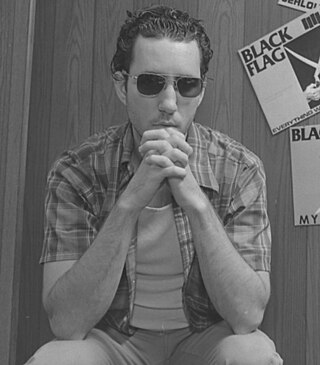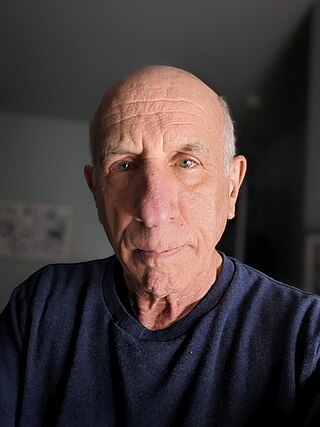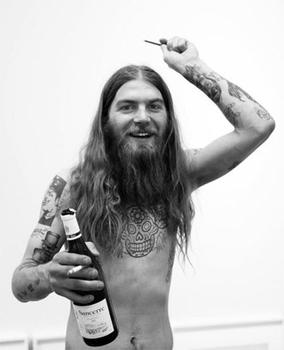
Raymond Pettibon is an American artist who lives and works in New York City. Pettibon came to prominence in the early 1980s in the southern California punk rock scene, creating posters and album art mainly for groups on SST Records, owned and operated by his older brother, Greg Ginn. He has subsequently become widely recognized in the fine art world for using American iconography variously pulled from literature, art history, philosophy, and religion to politics, sport, and sexuality.

Michael Kelley was an American artist whose work involved found objects, textile banners, drawings, assemblage, collage, performance, photography, sound and video. He also worked on curatorial projects; collaborated with many other artists and musicians; and left a formidable body of critical and creative writing. He often worked collaboratively and had produced projects with artists Paul McCarthy, Tony Oursler, and John Miller. Writing in The New York Times, in 2012, Holland Cotter described the artist as "one of the most influential American artists of the past quarter century and a pungent commentator on American class, popular culture and youthful rebellion."
Scott Benzel is an American visual artist, musician, performance artist, and composer. Benzel is a member of the faculty of the School of Art at California Institute of the Arts, Valencia, CA.

Kenneth Feingold is a contemporary American artist based in New York City. He has been exhibiting his work in video, drawing, film, sculpture, photography, and installations since 1974. He has received a Guggenheim Fellowship (2004) and a Rockefeller Foundation Media Arts Fellowship (2003) and has taught at Princeton University and Cooper Union for the Advancement of Art and Science, among others. His works have been shown at the Museum of Modern Art, NY; Centre Georges Pompidou, Paris; Tate Liverpool, the Whitney Museum of American Art, New York, among others.
Tony Oursler is an American multimedia and installation artist married to Jacqueline Humphries. He completed a Bachelor of Fine Arts at the California Institute for the Arts, Valencia, California, in 1979. His art covers a range of mediums, working with video, sculpture, installation, performance, and painting. He lives and works in New York City.

Dashiell A. Snow was an American artist based in New York City. Snow's photographs included scenes of sex, drugs, violence, and the art world; his work often depicted the decadent lifestyle of young New York City artists and their social circle.

Mary Lucier is an American visual artist and pioneer in video art. Concentrating primarily on video and installation since 1973, she has produced numerous multiple- and single-channel pieces that have had a significant impact on the medium.

Terry Alan Fox was an American conceptual artist known for his work in performance art, video, and sound. He was of the first generation conceptual artists and was a central participant in West Coast performance art, video and conceptual art movements of the late 1960s and early 1970s. Fox was active in San Francisco and in Europe, living in Europe in the latter portion of his life.

Jessica Stockholder is a Canadian-American artist known for site-specific installation works and sculptures that are often described as "paintings in space." She came to prominence in the early 1990s with monumental works that challenged boundaries between artwork and display environment as well as between pictorial and physical experience. Her art often presents a "barrage" of bold colors, textures and everyday objects, incorporating floors, walls and ceilings and sometimes spilling out of exhibition sites. Critics suggest that her work is informed by diverse artistic traditions, including abstract expressionism, color field painting, minimalism and Pop art. Since her early career, they have noted in her work an openness to spontaneity, accident and marginality and a rejection of permanency, monetization and disciplinary conventions that Stephen Westfall characterized as an "almost shocking sense of freedom."

Katy Schimert is an American artist known for exhibitions and installations that meld disparate media into cohesive formal and conceptual visual statements arising out of personal experience, myth and empirical knowledge. She interweaves elements of fine and decorative arts, figuration and abstraction in densely layered drawings and sculpture that together suggest elliptical narratives or unfolding, cosmic events. Curator Heidi Zuckerman wrote that Schimert is inspired by "the places where the organized and the chaotic intersect—the scientific and the mythic, the known and the unknown, and the real and the imagined … she creates work that exists where, through fantasy, truth and beauty meet."
Forcefield was an American noise band and art collective, founded in 1997 in Providence, Rhode Island, closely associated with Fort Thunder.
Phyllis Baldino is an American visual artist whose art engages in a conceptual practice that merges performance art, video art, sculpture, and installation in an exploration of human perception. Her single-channel videos are distributed by Electronic Arts Intermix in New York, NY. She currently lives and works in Brooklyn, New York.

Kristin Lucas is a media artist who works in video, performance, installation and on the Internet. Her work explores the impacts of technology on humanity, blurring the boundary between the technological and corporeal. In her work she frequently casts herself as the protagonist in videos and performances where her interactions with technology lead to isolation, and physical and mental contamination.

The Watermill Center is a center for the arts and humanities in Water Mill, New York, founded in 1992 by artist and theater director Robert Wilson.

Judith Barry is an American multimedia artist, writer and educator. Art critics regard her as a pioneer in performance art, video, electronic media and installation art who has contributed significantly to feminist theories of subjectivity and the exploration of public constructions of gender and identity. Her work draws on a diverse background, which includes studies in critical theory and cinema, dance, and training in architecture, design and computer graphics. Rather than employ a signature style, Barry combines multiple disciplines and mediums in immersive, research-based works whose common methodology calls into question technologies of representation and the spatial languages of film, urbanism and the art experience. Critic Kate Linker wrote, "Barry has examined the effects and ideological functions of images in and on society. Her installations and writings … have charted the transformation of representation by different 'machines' of image production, from the spatial ensembles of theater to computer and electronic technologies."
Carole Ann Klonarides is an American curator, video artist, writer and art consultant that has been based in New York and Los Angeles. She has worked in curatorial positions at the Santa Monica Museum of Art (1997–2000) and Long Beach Museum of Art (1991–95), curated exhibitions and projects for PS1 and Museum of Modern Art (MOMA), Laforet Museum (Tokyo), and Video Data Bank, among others, and been a consultant at the Getty Research Institute. Klonarides emerged as an artist among the loosely defined Pictures Generation group circa 1980; her video work has been presented in numerous museum exhibitions, including "Video and Language: Video As Language", "documenta 8," "New Works for New Spaces: Into the Nineties,", and "The Pictures Generation, 1974-1984", and at institutions such as MoMA, the Smithsonian Hirshhorn Museum, Contemporary Arts Center, the New Museum, The Kitchen, and School of the Art Institute of Chicago (2016). Her work belongs to the permanent collections of MoMA, the Whitney Museum of American Art, Getty Museum, Centre Pompidou, Contemporary Arts Museum Houston, Museu-Fundacão Calouste Gulbenkian (Lisbon), Museo Nacional Centro de Arte Reina Sofía (Madrid), and National Gallery of Canada, and is distributed by the Video Data Bank and Electronic Arts Intermix (EAI).
Frank Gillette is an American video and installation artist. Interested in the empirical observation of natural phenomena, his early work integrated the viewer's image with prerecorded information. He has been described as a "pioneer in video research [...] with an almost scientific attention for taxonomies and descriptions of ecological systems and environments". His seminal work Wipe Cycle –co-produced with Ira Schneider in 1968– is considered one of the first video installations in art history. Gillette and Schneider exhibited this early "sculptural video installation" in TV as a Creative Medium, the first show in the United States devoted to Video Art. In October 1969, Frank Gillette and Michael Shamberg founded the Raindance Corporation, a "media think-tank [...] that embraced video as an alternative form of cultural communication.

John Sanborn is a key member of the second wave of American video artists that includes Bill Viola, Gary Hill, Dara Birnbaum and Tony Oursler. Sanborn's body of work spans the early days of experimental video art in the 1970s through the heyday of MTV music/videos and interactive art to digital media art of today.
Chrissie Iles is a British-American art curator, critic, and art historian. She is the Anne & Joel Ehrenkranz Curator at the Whitney Museum of American Art in New York City.
Shalom Gorewitz is an American visual artist. Gorewitz was among the first generation of artists who used early video technology as an expressive medium. Since the late 1960s, he has created videos that "transform recorded reality through an expressionistic manipulation of images and sound". His artworks often "confront the political conflicts, personal losses, and spiritual rituals of contemporary life". Gorewitz has also made documentary and narrative films.















